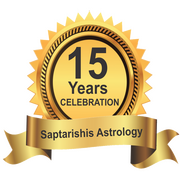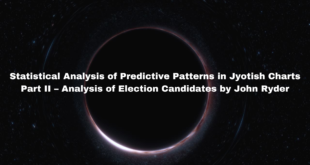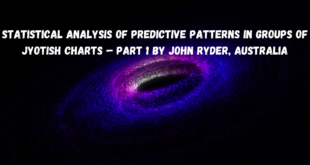Related Articles
I. Introduction
In Vedic Astrology, a number of dasha systems are used to predict how events will unfold in a person’s lifetime. At least 32 dasha systems are described by Sage Parashara in Brihat Parashara Hora Shastra (BPHS)1. Of these, the Vimshottari dasha system is the most popular as it is seen to produce reliable and accurate results. It is also the dasha recommended by Sage Parashara for the general populace.
In this dasha system, the complete span is taken to be of 120 years as the full life span of a human being is taken to be 120 years and the nine grahas (2 luminaries, 5 planets and two lunar nodes), referred to as simply planets or grahas after this, are assigned different periods designated as mahadasha period. However, it is remarkable that no explanation or clue (to the best of author’s knowledge) has been offered in any of the ancient texts as to the logic behind the dasha system.
A few speculations have been offered in recent times2-4 as to the logic behind these planetary periods. Dr.V.G.Rele2 believes that around 649 A.D., the planets were actually observed in the sky such that each planet was approximately posited in the nakshatra whose lord it is supposed to be. The dasha period is equal to the time elapsed between actual observation of the planet in its original nakshatra and its return to the same nakshatra or to ninth nakshatra on either side, when observed successively with one year interval. It is not clear whether the dasha sequence would have been different had the planets been originally observed at a different time or had the planets been observed in consecutive years on nights with different visibility or by different observers with varying sharpness of vision. Thus, the theory appears to be subjective. Also, the planets are only approximately in their assigned nakshatras, with Mercury being far away from its expected position. Most of the other theories3-4 assign points or numbers to a particular graha based on different criteria like the number of houses owned by it or its distance from its moolatrikona sign and then 1 year per point is awarded to the graha. The graha is expected to abide by this allotment and give suitable results.
In this article, an interesting observation regarding the mahadasha period of a graha and orbital or synodic period of its so-called rival graha is reported. Observations are also made on the total dasha span of 120 years. A plausible explanation for these observed results as also the order of Vimshottari dasha including the placement of Rahu and Ketu in it is offered in the next part.
II. Observations:
The dasha period of each of the planets is discussed in detail below and is shown to have a strong correlation with the orbital motion characteristics of its rival grahas. Planets form such rival pairs by virtue of being lords of houses or signs opposite each other or due to their natural enmity. In particular, the mahadasha period is seen to correspond consistently with 10 synodic periods or 10 orbital revolutions of rival planets as defined in this article, or to one third their orbital period i.e. the time required to sweep through the nine nakshatras owned by nine lords of Vimshottari system. At the same time, it is noticed that these periods may also coincide with other major events associated with rival planets.
It should be noted that each planet in a rival planet pair is seen to determine the dasha period of other planet in the pair. As such, both the planets are loosely called rivals in this work even though they may not be so naturally e.g. as given below, the dasha period of Jupiter depends upon its enemy, Venus. Similarly, the dasha of Venus depends upon Jupiter since it is a part of the rival pair although Jupiter is not considered a natural enemy to Venus or to any of the other planets.
Further, it is to be remembered that the dasha period is given in full years corresponding to the solar return point at the start of the dasha period.
The synodic period of two bodies orbiting a central body is the period or time after which all three bodies align along a staright line and is calculated as
where P1= orbital period of revolution of body 1,
P2= orbital period of revolution of body 2 and
S=synodic period of two bodies.
The planets are assumed to revolve in circular orbits around the Sun and all the orbits are assumed coplanar; or all the planets are assumed to revolve around the Sun in the ecliptic plane.
Thus, from the above formula, the synodic period is the temporal interval that it takes for an object to reappear at the same point in relation to two other objects (linear nodes). The central body in above formula is taken as Sun for heliocentric system and Earth for geocentric system. It should be mentioned here that the synodic period of Sun with two planets other than Earth e.g. Mars and Saturn need not mean that Earth and these two planets are also aligned after this period. A more general definition of synodic period is the period after which the two lines joining the planets in question e.g. Sun-Mars line and Sun-Saturn line, make the same angle with each other. For an angle of 0 degrees and as the Sun is common to both the lines, these lines coincide and the planets get aligned along a straight line. In other words, when seen from the Sun, Mars and Saturn are the same point in the zodiac.
The orbital period of a planet is its sidereal period of revolution round its parent body i.e. the Earth in case of Moon and its nodes and the Sun for all other planets. The sidereal period is defined as the temporal cycle that it takes an object to make one full orbit relative to the stars as seen from a central body. This is considered to be an object’s true orbital period.
The orbital periods of planets round their parent body and synodic periods relative to Earth as seen from the Sun (or relative to Sun as seen from Earth) are given in Table 1.
Table 1 Orbital and Synodic periods of grahas
Sr. No | Planet | Orbital Period Years (Days ) | Synodic Period Days |
1 | Sun | 1.0 (365.254) | – |
2 | Moon | 0.0748 (27.3 ) | 29.5 |
3 | Mars | 1.881 | 779.8 |
4 | Lunar Nodes | 18.6 | 346.6 |
5 | Jupiter | 11.86 | 398.9 |
6 | Saturn | 29.45 | 378.1 |
7 | Mercury | 0.241 | 115.98 |
8 | Venus | 0.615 | 583.9 |
Dasha Periods
In view of the preceding discussion, some important observations regarding the dasha period of each planet is given below:
Sun- 6 years
During this period, Venus, one of the bitter enemies of the Sun, completes almost 10 revolutions around the Sun. One revolution of Venus around the Sun takes 0.61 years. Ten such revolutions rounded to nearest year would be 6 years.
Neptune, often considered to be the higher octave of Venus, moves one nakshatra. (165/27=6.1 years). It is often observed that planets give noticeable results during transition from one nakshatra to other or from one sign to other as in the case of sadhesati. The change of mahadasha is similarly a period to watch out for.
The 18 year Saros eclipse cycle was known during Rgvedic period and the cycle was further divided into three cycles of 6 year each5.
Rahu (lunar node), another enemy of the Sun, moves through nine nakshatras owned by all the nine planets of Vimshottari system in 6.2 years, and a new cycle of nine nakshatras begins.
If the dasha period is divided into two equal halves similar to night and day of the devas, one part is ruled by the Sun and the other part by Varuna. Thus the Sun has a period of 60 years. The dasha period of inner planets or the first five planets in the dasha system viz. Mercury, Ketu, Venus, Sun and Moon is 60 years, with the rest making up the remaining 60 years. The Shashthihayani dasha depending upon the placement of Sun is also of 60 years. In this dasha system, too, the span allotted for Venus, Saturn or Rahu is 6 years each. 6 years is one tenth of 60 years.
The effective period of Sun is said to be an ayan or 6 months i.e. half its revolution period of 1 year. Correspondingly, if Jupiter can be thought of as taking over the role of Sun after birth in the Vimshottari system (see Section III), the dasha period of Sun is one ayan or one half of Jupiter’s revolution period of 12 years (11.86 years).
If Jupiter’s position in the zodiac at the start of dasha is taken as its ascendant, then Jupiter goes to the region called Bhu loka (the earthly plane, from the longitude of the descendant to the end of the sign) after 6 years. It shows death and re-birth as this is also the Mrityu loka or ‘where death occurs’ and this is where the dasha ends.
Moon- 10 years
Saturn, who considers moon as its enemy, moves through all the nine nakshatras owned by nine dasha lords of Vimshottari system in this period (29.4/3=9.8 years) of 10 years completing one cycle. The orbital period of Saturn is often approximated as 30 years e.g. for calculating sadhesati.
The Earth along with its companion, the Moon, completes 10 revolutions around the Sun. When seen from Earth, the lunar nodes (or moon’s rivals) complete 10 synods with Sun. Rahu and Ketu interchange positions in 10 years.
Mars- 7 years
Mercury is an enemy of Mars. The number 7 is closely associated with orbital motion of Mercury as the orbital period of Mercury is almost exactly 7/29 years and the synodic period is almost equal to the inverse of mystical pi (1/π) or 7/22 years. Thus, Mercury completes almost exactly 29 revolutions around the Sun in 7 years and at the same time completes 22 conjunctions with the Sun as seen from Earth.
The planet Uranus, often considered to be the higher octave of Mercury, moves one sign in this period (84/12=7).
Venus, although neutral with respect to Mars, owns the houses exactly opposite to those of Mars (The other pairs being Saturn’s houses opposite to those of Moon and Sun, and Mercury’s houses being opposite to those of Jupiter’s) and is of opposite polarity to Mars (as in ‘Men are from Mars,…’). Now, one of the possible orbits after Mars as given in Section III is 4.36 years (The period of asteroid Ceres is 4.6 years). The synodic period of Venus and an object in this orbit is 0.72 years (4.36*0.616/(4.36-0.616)=0.72). The synodic period of Venus and Ceres is 0.71 years. A dasha period of 7 years corresponds to 10 such synods. If the asteroids are taken to correspond to Rahu’s orbit (see Part II), this period corresponds to 10 synodic periods of Venus and Rahu. As is known, Rahu is also an enemy of Mars.
Rahu- 18 years
18 years is nothing but the Saros period when the Sun and Moon (Rahu’s enemies) join hands and the same pattern of eclipse repeats. The moon completes an integral number of synodic, anomalistic and nodical months during this period. The next Solar eclipse moves 120o in longitude or across 9 nakshatras of Vimshottari system during this period. This is 1/3 the time of 54 years required for it to come back a full circle viz. Triple Saros.
Jupiter- 16 years
The synodic period of Venus with Sun is 1.6 years and as seen from Earth, it completes 10 encounters with the Sun during this mahadasha period, twice repeating the famous pentagram of Venus. Venus is one of the enemies of Jupiter.
16 years is also approximately one tenth of the orbital period of Neptune, the higher octave of Venus (165/10=16.5 years)
Saturn- 19 years
This is the period of Metonic cycle of Moon, an enemy of Saturn. Moon repeats the same phase and is at the same position in zodiac after this period corresponding to 235 synodic months. This leads to lunar eclipses occuring on about the same calendar day and at almost the same time (within a few hours) separated by 19 years.
Mars, another enemy of Saturn, completes 10 revolutions around the Sun. The orbital period of Mars is 1.881 years, very close to 1.9 years. (1.881*10=18.81 years).
Mercury- 17 years
Mars considers Mercury as its enemy. Now, if the definition of synodic period given earlier as that of repeating the same angle between two lines is used, the Sun-Mars line and the line joining lunar nodes are at the same angle relative to each other after every 1.708 years. Thus, after every 1.708 years, the Sun-Mars line again becomes parallel to the nodal line, assuming initially these two lines were parallel or coincident. After ten such similar configurations of Sun and Mars line with the nodal line or after approximately 17.08 years, these two lines almost coincide i.e. Mars and Sun also align closely with actual lunar nodes Rahu and Ketu when seen from Earth. As is known, Mars and Rahu are enemies as well.
It should be remembered that the nodal line is in fact a vector in that the sense of direction from Rahu to Ketu is opposite that from Ketu to Rahu. In other words, for parallel alignment, say the node Ketu as seen from Earth has to be in the same nakshatra as Mars when seen from Sun. When Rahu seen from Earth and Mars seen from Sun are in the same nakshatra, it can be called opposition. Similarly, aspects between other pairs of planets could also be defined.
Since the nodes define a line and orbit round Earth as against the revolution of other planets round the Sun, this definition is more relevant. It is equivalent to polarization matching between two electric or magnetic dipole antennas.
Also, seen from Earth, eclipses are possible if Sun and Moon are positioned on the axis defined by lunar nodes. When seen from the Sun, such a situation is possible if a line parallel to the axis of lunar nodes is drawn through the Sun, and Moon and Earth are present on it. In fact eclipses are possible only when both these lines coincide. This axis spins around the Sun with retrograde motion and orbital period of 18.6 years. The nodes Rahu and Ketu could alternatively be defined on this line, say, at points where this line intersects the orbit of asteroids (see Part II). Then, the synodic period of Mars with this Rahu is 1.708 years (1.881*18.6/(1.881+18.6)=1.708 years). 17 years corresponds to 10 such synodic periods.
17 years is also almost 8 times the synodic period of Mars with Sun and at the same time 9 times its orbital period. This is similar to the multiples of orbital and synodic periods completed by Mercury, a rival of Mars, within the dasha period of Mars.
This period is also equal to the perihelion opposition of Mars or the period after which Mars is closest to earth.
17 years is also almost 1/10 of the synodic period of Uranus and Neptune ( 171.1 years). Uranus is considered to be the higher octave of Mercury.
The moon is an enemy of Mercury. 17 years is also the interval after which the moon’s following phase is repeated6.
Ketu- 7 years
By the saying kujovat ketu (Ketu is similar to Mars), the dasha periods of Mars and Ketu are equal.
The synodic period of Jupiter and Rahu as defined in the discussion on Mercury’s dasha period earlier (point 7) is almost 7 years [11.86*18.6/(11.86+18.6)=7.24 years]. The Sun-Jupiter line makes the same angle with the nodal line after every 7.24 years or both lines become parallel after this period if initially parallel or coincident. If corresponding nodes are defined on, say, the orbit of asteroids as discussed earlier, Jupiter then crosses the line of these nodes every 7.24 years. As seen from Earth, the Sun, Jupiter and lunar nodes (Rahu and Ketu) are also in close alignment (within about 7 degrees) after approximately 7.1 years.
Interestingly enough, and taken together with the discussion on dasha period of Mars, it is known that the strongest planetary tidal forces acting on the lunar orbit come from the planets Venus, Mars and Jupiter.
Venus- 20 years
Venus is an enemy of Jupiter and the synodic period of Jupiter with another massive planet Saturn is 20 (19.9) years.
The synodic period of Mars with Saturn is 2 years (1.881*29.45/(29.45-1.881)). Mars is not a friend of Venus, but it is a sama (neutral) planet to Venus. However, the houses owned by Mars (1st and 8th) are exactly opposite those owned by Venus (7th and 2nd) making these planets of opposite polarities and rivals as discussed earlier. Mars is an enemy of Saturn. 20 years corresponds to 10 cycles of this synodic period.
According to Vedanga Jyotish7, the Sun and Moon (both enemies of Venus) are supposed to meet in the same nakshatra e.g. Dhanishtha, after 5 years (5 year yuga). 20 years corresponds to 4 such meetings or a chaturyuga.
The planet Pluto considered to be a higher octave of Mars has a mean motion of approximately 20 years in one sign (248/12=20.67 years). Given the long orbital period and eccentricity of Pluto’s orbit, 20 years is a fair estimate for the mean period of stay in one sign. If we remember that the internal motion of the microcosm directly affecting us and mirroring the macrocosm (see Part II) need not have the same orbital eccentricity as the planets in macrocosm, the mean motions may very well be taken for dasha calculations.
III. 120 year span
A few observations may be made for the 120 year span:
- The span of life in Kaliyuga as given by Sage Parashara is 120 years.
- Venus (Shukra also means semen) is supposed to be responsible for life and the first month after conception is ruled by Venus. Now, during the time it takes for human birth to take place or gestation period to end, the Moon completes ten full revolutions and the Sun rotates 10 times as seen from Earth. The orbital period of Moon or the synodic period of Sun’s rotation is each equal to 27.3 days. Moon and Sun are both enemies of Venus. Jupiter who considers Venus as its enemy fulfills the same role after birth as done by Sun and Moon before birth. For Shukra, the total span of 120 years is 10 times the orbital period of its rival, Jupiter.
- If Jupiter is life or jeeva, the total dasha span as per the above observations ought to depend upon its rival such as Venus. It is known that the transits of Venus have a repeating pattern after 243 years. Before about 500 A.D., the transits were spaced 121.5 years apart8. When lifegiver Venus itself passes over the fiery disc of Sun after around 121.5 years, the dasha cycle can be said to have come to an end after about 120 years.
- The conjunction of Jupiter and Saturn takes place at the same position in zodiac after around 60 years. Two of these (ahoratra or day and night, aroha and avaroha) correspond to 120 years. The 60 year period is also divided into three twenty year synodic periods attributed to Brahma, Vishnu and Shiva, respectively9.
- If the successive possible orbital periods between planets starting from Mercury are taken to be multiples of 1.6335 to approximately fit most of the existing planets, then we get the orbital periods (in years) as 0.23 (Mercury- 83.8 days), 0.612 (Venus 223.6 days), 1.0 (Earth), 1.63 (Mars), 4.36 (Asteroids- Rahu/Ketu ?), 11.63 (Jupiter), 31 (Saturn), 82.8 (Uranus), 221 (Neptune/Pluto ?). Except for Mars and its higher orbit Pluto (and with the notable exception of Neptune), these agree to within 5% of their orbital periods as known today. Slight changes or modifications in this could have occured due to the supposed disintegration/nonformation of the object in the asteroid belt. Uranus is considered to be the higher orbit of Mercury and their orbital periods are also similar if we substitute one day for one year. The next orbit has similarity with orbit of Venus taking one day for year. However, as there is Neptune after Uranus and from the observed astrological results, this orbit is considered to be the higher octave of Mars.
The next orbit after 221 years in our calculation of planetary periods using this simple formula is 360.9 yearsNote 1. Because of the similarity of this orbital period with Earth (one year for one Earth day) and the description of one day and night of Gods being equal to one year, it is possible that the fate on earth is governed by this higher orbit (of perhaps Rahu or Jupiter?) or the equivalent of this in the inner cosmos/ bio rhythm. An object in this orbit would sweep across nine nakshatras of Vimshottari system in 120 years, giving the total dasha span for nine planets of 120 years. It is worthwhile to note that in Uranian astrology, too, a trans-neptunian planet aptly named Hades is supposed to have an orbital period of 360.6 years10.
Finally, 120 is the product of first five numbers (1x2x3x4x5) and conveniently divisible by 2,3,4,5,6 and 8. Also, one less of 120 (119) and one more of 120 (121) is divisible by two sacred prime numbers viz. 7 and 11, respectively.
Inferences drawn from observations:
The dasha periods are seen to correspond with 10 synodic periods or 10 orbital revolutions of rival planets or time taken by them to traverse the nine nakshatras owned by nine planets of Vimshottari dasha system. The dasha period thus corresponds either to one transit of nine nakshatras or to 30 such transits. This ratio is the same as the ratio between periods of revolution of Earth and Saturn around Sun.
A high degree of symmetry is observed in the determination of dasha periods e.g. the dasha period of Moon depends upon Saturn and that of Saturn upon Moon’s metonic period. The other pairs are Venus/ Jupiter, Mercury/Mars and Rahu/Sun. Another interesting symmetry is observed for Mars/Venus pair with the dasha period being given by synodic period of the other planet in the pair with an enemy of Mars. In fact Mars, the warrior General among the planets is seen associated simultaneously with two other rivals like Venus-Rahu, Mercury-Rahu or Saturn-Venus.
The period of Sun is one third of Solar eclipse period caused by Rahu or approximately one third of Rahu’s period of revolution while the period of Rahu in turn is one third of the complete revolution period of Solar eclipse viz. 54 years (triple Saros).
The dasha period of Sun and Moon together (16 years) is one third of Saturn and Rahu’s periods (18.6+29.4=48 years).
If an year of 360 days is taken, most of the dasha periods remain almost the same. However, 10 year dasha period of Moon corresponding to 3600 days is almost equal to 31 synodic periods of Mercury. Moon is an enemy of Mercury. The 10 year dasha period of Moon and 20 year dasha period of Venus would then correspond to almost exact multiples of lunations of 29.5 days each with perhaps one intercalary day per 10 years. The orbital period of Saturn is also 29.8 such years and one third is close to 10 years. Similarly Jupiter’s period is 12.03 such years. Thus, one half of this or equivalent ayan is 6 years for Sun’s period. The period of Mars is 1.9085 such years and ten times is 19.085 for Saturn’s period.
Conclusion
It has been shown in this article that the dasha periods of planets in Vimshottari dasha system may very well be determined from the orbital properties of their rival planets as defined in this article. It was consistently observed that this period is either equal to 10 synodic periods or 10 orbital revolution periods of these rival planets or the time taken by them to traverse the nine nakshatras owned by nine dasha lords of Vimshottari system. A high degree of symmetry was also observed in the calculations leading to pairs of planets with interdependent dasha periods. It is possible that the above criteria could have played a role in the determination of dasha periods of planets and the total dasha span.
Note 1:
a) Interestingly, by taking successively higher orbits and starting from Mercury with an orbital period of 0.23 years, the orbital period for a body in the 71st orbit after this or after 71 interorbital distances is given by 0.23*1.633571 This equals 3.11*1014 years or is almost equal to the age of Brahma(3.11*1014 years) . The time taken to traverse the diameter of this orbit with about the same speed as orbital velocity of this body is approximately equivalent to 3.11*1014 /π≈1014 years. The exponents indicate an almost eerie resemblance to 71 manvantaras and 14 manus.
b) Similarly, the closer in orbits could be calculated by extending this logic. For example, the period of body in an orbit that is 12 orbits inward from the Earth’s orbit is 1.6335-12 years = 1 solar day. The days and years of superior worlds or lokas are given in various ancient texts. By the same logic, the days and years of some subtler or microcosmic worlds may be calculated e.g. for some loka one year could be equal to our one solar day or the approximate time spent by moon in one Thus, each day or each nakshatra could be associated with one planet. The duration of their day would then be around 4 minutes. For such a world whose 1 year is equivalent to our solar day, the synodic period of first planet from Sun, Mercury would be equivalent to around 120 (116) years of that world. The 7th orbit outward from 4 minute orbit would be around 2 hours (125 mins.) or time taken by the lagna in one rashi. It is the equivalent of a month in our system. Half of this or one fortnight would be one hora and it is known that days of week can be derived by associating each hora with one planet of solar system, starting from slowest viz. Saturn and moving sequentially upto the fastest viz. Moon. Other familiar time periods such as 28.7 minutes (approx 1 ghatika), 47 mins (app. 1 Muhurta), 7.2 days (app. 1 week) and 31 days (app. 1 month) are also encountered as orbital periods with this factor of 1.6335 chosen from inspection for an approximate fit of planetary orbital periods. By experimenting with this factor a number of other interesting periods coinciding with known natural phenomena emerge.
c) The above could be the microscopic cycles affecting us on a day to day basis (particularly before birth) or even subtler orbits could be thought of by delving deeper iteratively. Going 108 such orbits inward from the orbit of Venus, we get 1.86*10-16 as the period for 108th orbit and 1.14*10-16 for 109th orbit. This is close to 1.5*10-16 sec period of the first electron orbit for Hydrogen atom in the Bohr model. In fact, the average of 108th and 109th orbits is 1.5*10-16 sec. By taking a slightly different factor of 1.6366, we get 1.5*10-16 for the 108th orbit This journey of 108 higher orbits from microcosm to macrocosm could be the basis behind ‘shri shri 108’ prefix before the name of holy men.
Learn Astrology: Join Our Upcoming Astrology Classes — Click Here
Learn Astrology: Join Our Recorded Astrology Classes — Click Here
 Saptarishis Astrology Magazine Into Creating Astrologers
Saptarishis Astrology Magazine Into Creating Astrologers






